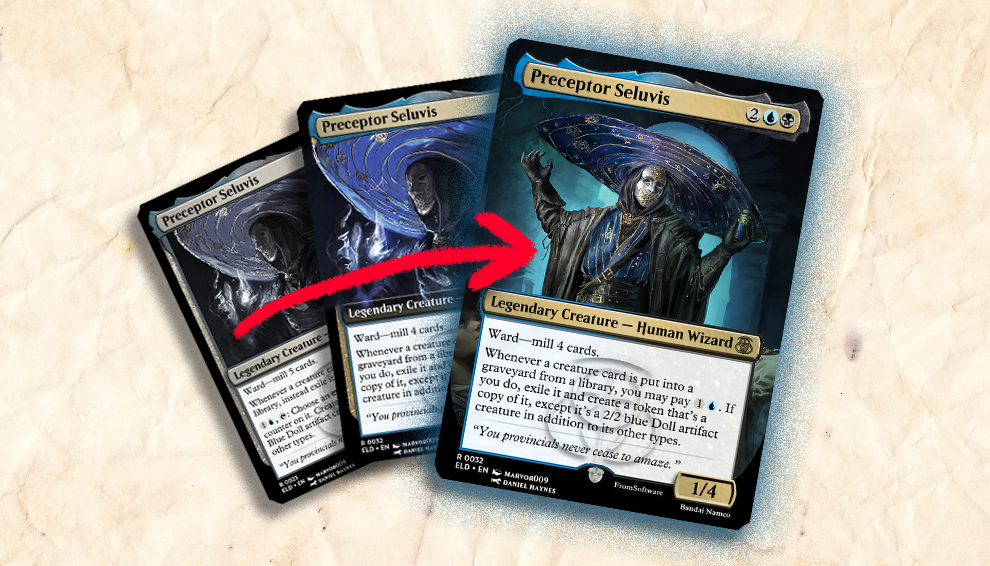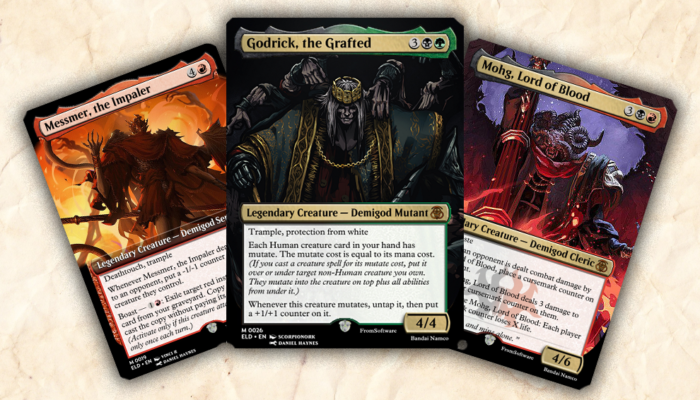Hello there again!
In my last post, I shared a couple of custom Elden Ring themed legendary creatures for Magic: The Gathering that I’d been designing for fun. Though, this time around I want to take a different approach. I have made a single legendary creature card this time and taken the time to playtest and iterate on the card thoroughly over the course of two weeks to see what results I get, hopefully learning something about MTG card design/balancing in the process. For the playtests, I was playing with friends of varying skill levels using a variety of decks on Tabletop Simulator. In this post, I am going to take you step by step through my iterations and my thought process when making changes.
Before we get started, below are the links the tool I used to make the card, the final deck, and the .json of the deck to download if you’d like to test the final result yourself in Tabletop Simulator:

Well, let’s go over what I learned!
First, here are some of my constraints I went in with:
- Custom card is a legendary creature.
- The card is balanced only for the Commander (EDH) mode of play.
- The card should represent the essence of the Elden Ring character it is based on through its appearance and playstyle.
- Card should not be designed entirely to achieve its win condition without other cards (“a self fulfilling prophecy”).
- It should be as novel and unique as possible within the bounds of MTG rulings.
- Card contents should be designed elegantly, with as little word/feature bloat as possible.
- Playtesting should be tested against different opponent decks, and different numbers of players where possible.
- Its deck should be made from existing non-custom commander legal cards.
Preceptor Seluvis
For this new card, I chose to explore further into which characters in Elden Ring had interesting lore and archetypes that would allow for some fun mechanics and card flavour. My mind wandered this time to Preceptor Seluvis from the Ranni questline. His whole character is that of a very conniving, clever, and dark wizard. His main trait is that he secretly takes people’s souls and puts them into dolls in his basement for his own amusement. In the game, these can be offered to the player as unique summons though they aren’t any more powerful than a standard Spirit Ash. The doll-keeping aspect of his character seems very interesting. Keeping some form of card or creature in a vessel of some kind – perhaps collecting them or gathering them to fight for him.

My immediate thoughts for avenues this could go down were:
- Some form of Manifest keyword on as a trigger or activated ability.
(E.g. Tap to manifest top card of your library as a 3/3 creature etc.) - He’s a wizard, so some form of control to transform powerful enemy creatures on the battlefield into dolls on trigger or activated ability.
- Gain control of enemy creatures, but they change type or stats.
- A mill-based reanimator archetype.
- Some sort of interplay with artifact permanents he owns that can somehow “take” enemy creatures (the suspicious potion he uses in Elden Ring as flavour)
- He’s clever, conniving, AND a strong wizard so he would want to steal/kill/remove/mill the permanents you care most about and/or transform them into doll creatures under his control.
- He’s blue/black Dimir with a focus on milling your library to sift through your creatures and turn them into puppets – like he’s stealing the souls from your deck. Maybe stealing creatures that are milled?
With these ideas in my head, my mind immediately recalled a card I find particularly interesting in black, Dauthi Voidwalker. TLDR; it exiles away any cards that enter opponents graveyard whilst its alive, which is lovely by itself, but it is also able to sacrifice itself at any point to cast one of those cards for free at instant speed. The cards exiled are lost permanently, and because of the counter placed on them, future Dauthi Voidwalkers may keep “inspecting” from that same stolen pile of exiled cards. I love this powerful effect because of the complete freedom it card grants. Every game truly feels different due to sheer variety of cards you’ll gain access to during play. It’s also a nice little problem for the opponent if it stays down for a while.
I want Seluvis to play like this, but instead do something different that more suits his “doll-making” archetype.

Iteration #1
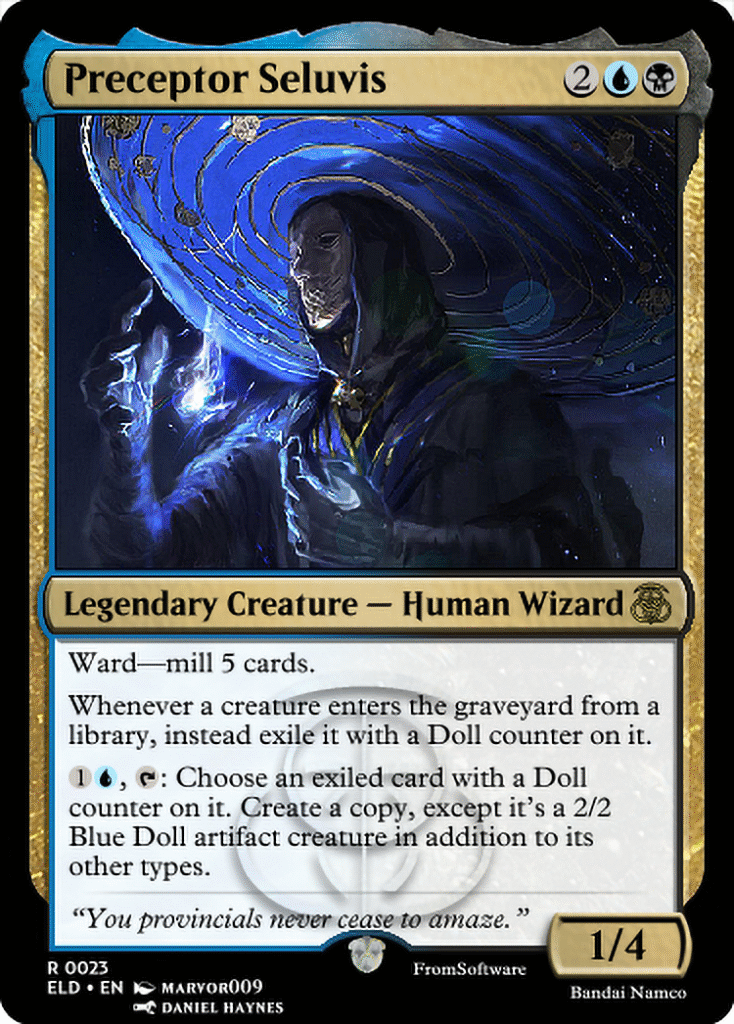
Here is my very first iteration. It is more or less a legendary permutation of Dauthi Voidwalker for the Dimir combo of colours at 4 CMC rather than Dauthi’s 2. He has a legendary body, so very unlikely he’s going to be duplicated during play due to the Legendary Rule – so I’m not too focused on that becoming a problem especially since his ability is a replacement effect which by nature cannot happen twice.
The 2UB Dimir colour identity would put him at a nice starting cost for testing for his effect, and for commander would determine his identity as Blue/Black – meaning decks made with him at the helm can only be of those two colours. The Dimir combination of colours in MTG is centred mainly around reanimation, strong removal, and a focus on “milling” cards (putting a card from target player’s library to the graveyard).
His weak but semi-sturdy statline reflects the focus on the strength of his abilities. A 1/4 statline deals no damage and discourages combat, but also keeps him just out of reach from cheap damage removal like Lightning Bolt and Shock, which would feel terrible to play into when considering his 4 CMC commitment to cast him.
In terms of player fantasy, Seluvis is a wizard, so he should feel like he is quietly assessing the opponent’s decks from a safe distance with no interest in getting into petty skirmishes. Pah! This invites opponents to remove him by other means to stave off his powerful effect, so I placed a deterrent in the form of a Ward ability, granting some nice tension to opponent holding a removal spell because of the innate synergy with his main triggered ability (whenever a creature…) and his Ward effect forcing to mill 5. Value! Now, I will argue this version is the closest the card was to having too much synergy with itself and breaking my constraint of having a “self fulfilling prophecy”. In later iterations, I do address this.
Now, for the effect, the idea was that it sits there and absorbs the “souls” of creatures that enter the graveyard. The “creature” constraint was mostly chosen as flavour to retain his essence as a dollmaker, but I think it also gives it a nice coincidental balance that keeps it feeling orthogonally unique from Dauthi. After he has collected said cards with his unique Doll tokens (which remain permanently throughout play), he can choose to tap and pay a small amount of mana at instant speed and cast a copy of any of the creatures he’s collected during the course of the game, albeit in very small form. The 2/2 form of the creature was chosen in an attempt to retain that essence of a mostly powerless summon, but when the summon has a brilliant ETB (Enter The Battlefield) effect or a very potent passive ability, Selvis’ menagerie of collected creatures should grow to become very mighty indeed. The idea of any creature being summoned for cheap, exploiting its powerful text regardless of cost or size was actually inspired by Barnes’ ability from Hearthstone. Love this guy.
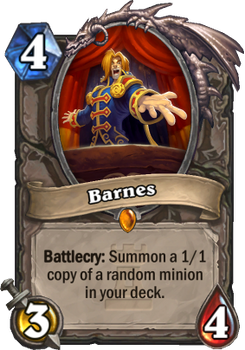
In the next section, I will address the inherent problems with this first version – and why Dauthi was clearly designed with the intent to be sacrificed and not kept on the field… Oh dear.
What I found out from playtests…
After around 6 games using Seluvis as my commander in a Dimir mill deck with a splash of control and a semi-focus on artifacts (final decklist available at the start of the post), I came to some realisations:
- The core activated ability can be repeated ad infinitum on the same exiled creature. Meaning there is no reason to not spam the most broken card you land on – which isn’t very tense or interesting since Seluvis mostly sits there and reaps the rewards passively anyway.
- In terms of variety and flavour, Seluvis should instead feel like he has a wide collection of useful dolls at his disposal, not just one silver bullet.
- His ward ability gives you too much automatic value with very little player interaction, he just exiles and stores likely 1-2 creatures per Ward trigger, which he would need to be resummoned after that removal to reap the reward (a kind of design dependency that would be very odd in another format).
- The artifact creature type is less impactful than I originally feared it might be (easily removed, synergy with lots of recently banned cards), but it appears to be fine as is.
- He’s boring and surprisingly weak on the whole.
- His main impact is to sit there on the field and reap rewards from huge mill cards to hopefully hit one strong creature, then spam it. The wording is lax enough on the triggered ability to allow self-mill as well as standard milling of an opponents deck, which is interesting and fairly open ended, but there’s no reason you wouldn’t just mill yourself for something like Hullbreaker Horror then win the game out of nowhere. At his strongest, the win feels unearned.
Iteration #2
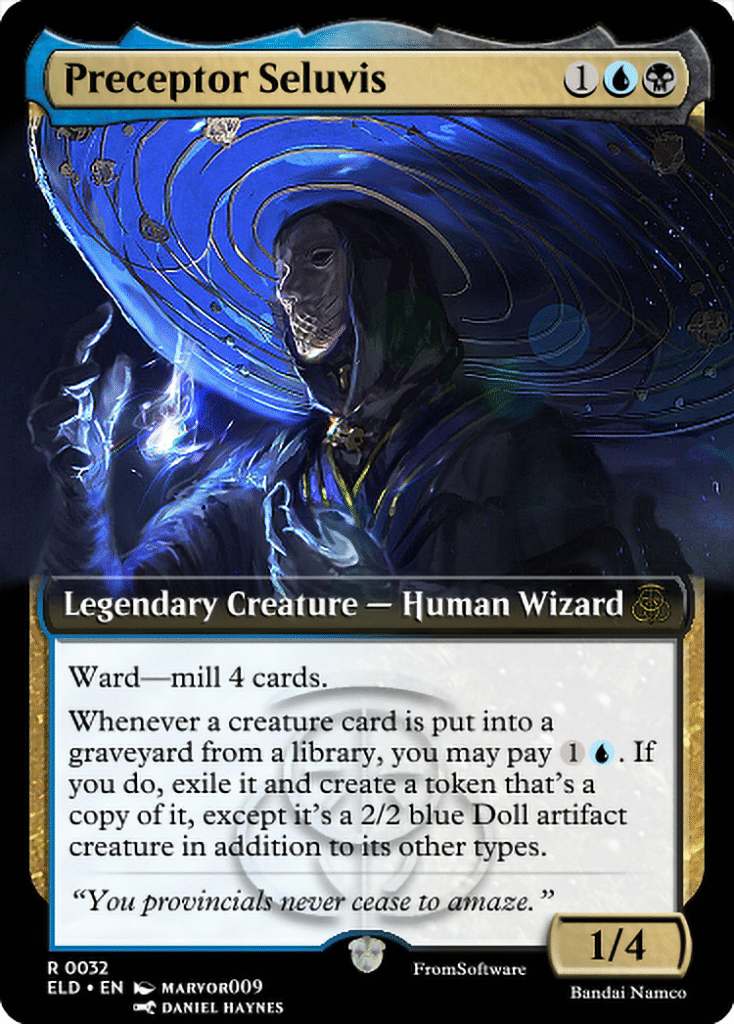
New changes I made:
- Ward effect – reduced cards milled by 1.
- Cost – reduced by 1 colourless mana.
- Both triggered ability and activated ability removed and reconsolidated into a new, more elegant mechanic.
- New border style, woo!
Firstly, the change to Ward was to round off the number in preparation for my prediction that the new ability will be a little more consistent/stronger than the last set.
The cost being reduced by 1 was in response to Seluvis feeling awfully slow to recast after death when offset by growing commander tax, especially when pitted against the strength of the strength and speed of the average commander deck. In retrospect, this looks kind of strong, especially when paired with a ward effect that is still quite good. I think nerfing his toughness down to 3 as well could have been worth considering.
Now for the main event! The new ability was an attempt to solve the aforementioned problems I had with the original set of abilities. First off, the new paragraph keeps the essence of Seluvis’ original “stealing” of milled enemy creatures, but instead, to introduce some worthwhile player interaction and tension, there is a required payment to bring that creature back in. The fundamental difference with the creature tokens created in this version is that 1; you have to plan ahead of time and reserve mana for the effect that summons them, and 2; that effect is instantaneous and requires immediate action otherwise you lose the chance to exile and steal said creature. This means the player using Seluvis will have to actively think about management of their mana and inherently removes the ability to spam the same creature over and over. This should create a playstyle that feels like you have to cleverly adapt to what you find on the fly – hopefully making it feel much more fun and replayable too.
A key part of balancing this ability for me was considering the cost paid against the body created. I wanted the ability to be elegant and simple, with a focus on making good use of strong creature abilities and not really using them for combat damage. This made me ditch an early idea for the cost being U(X), where X/X would be the creature copy’s statline, allowing the player to pay for any amount for the creatures body – but that felt like it went against the card’s intended strategy and Seluvis’ character. It also introduced some bloat to the design which felt out of place. All of Seluvis’ dolls should be equal and the strategy should be to make important, selective choices of what you sift through to steal/exile. This theoretically, however, does change the slow, repeated nature of his previous playstyle to something more explosive and high-tempo when played well.
What I found out from playtests…
- The ability was just as good at removing strong key creatures in an opponents deck as it was stealing them for yourself. This emerged naturally as a unique side-strategy during my play and ended up putting a lot of pressure on the opponents, marking Seluvis as a real threat whilst he remained on the board.
- Card draw is a noticeable weakness for the deck I built, whether or not it was the fault of Seluvis’ design or my card choices are unclear.
- Self-mill as a strategy felt consistent and fun. Running lots of high-impact creatures with powerful abilities and forming a unique strategy from the ones you choose felt awesome and a relevant expression of my skill. I can imagine people going in very different directions with this card’s ability.
- The cost of the card was a major complaint. It now being 3 CMC turned out to be much too easy to cast for his new abilities. I agree that he felt like he came down 1 turn earlier than he should, so this is the next key change coming.
Here are some cards that I found synergised extremely well with Seluvis:
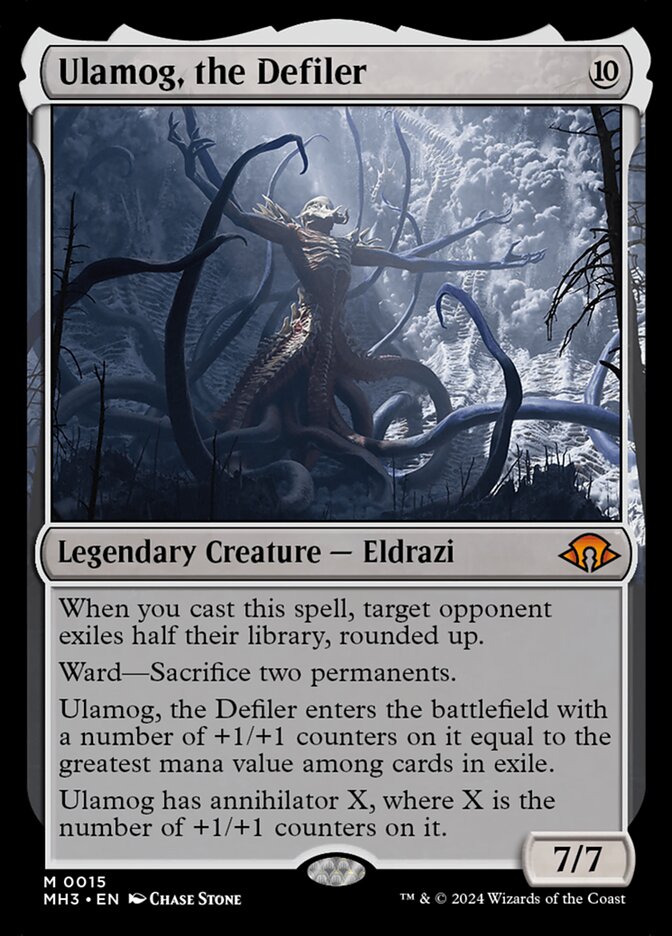
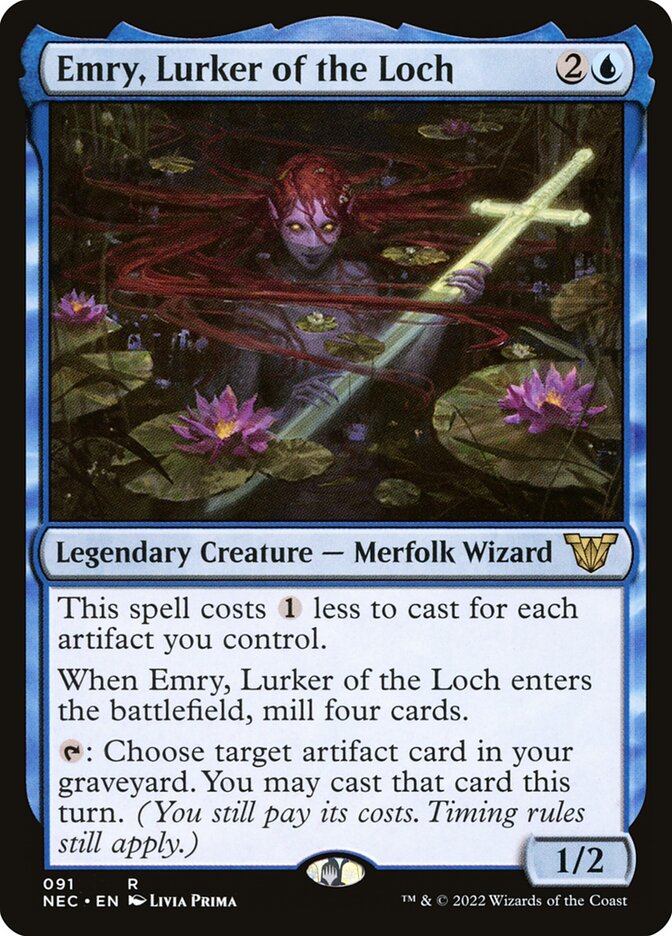
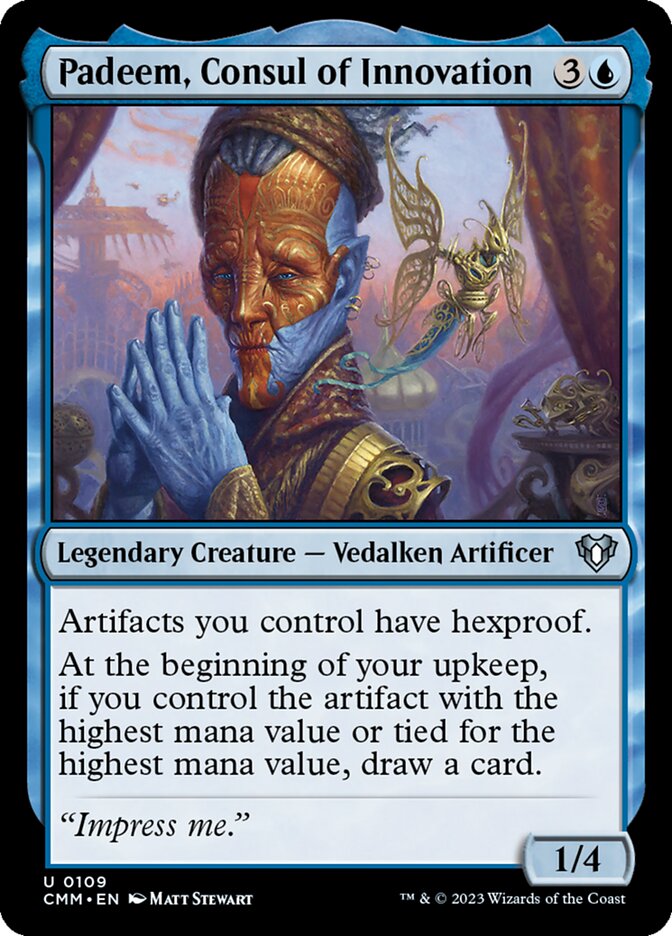
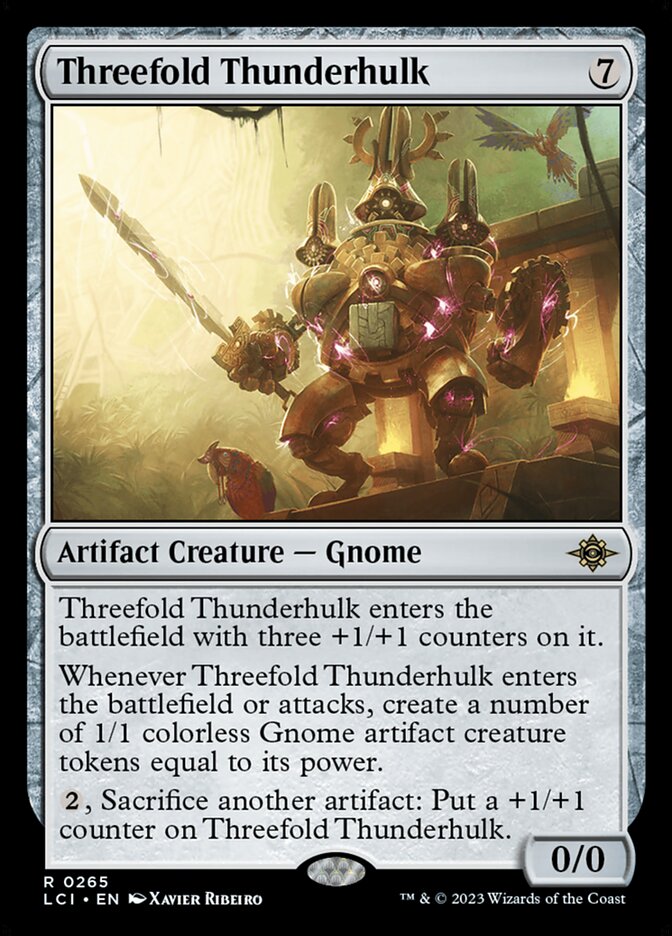
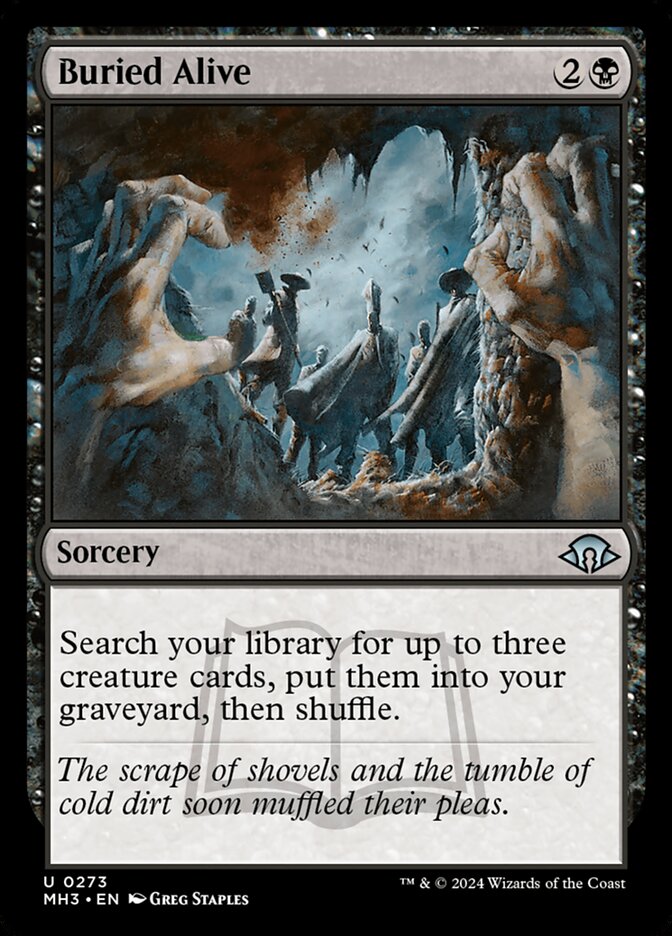
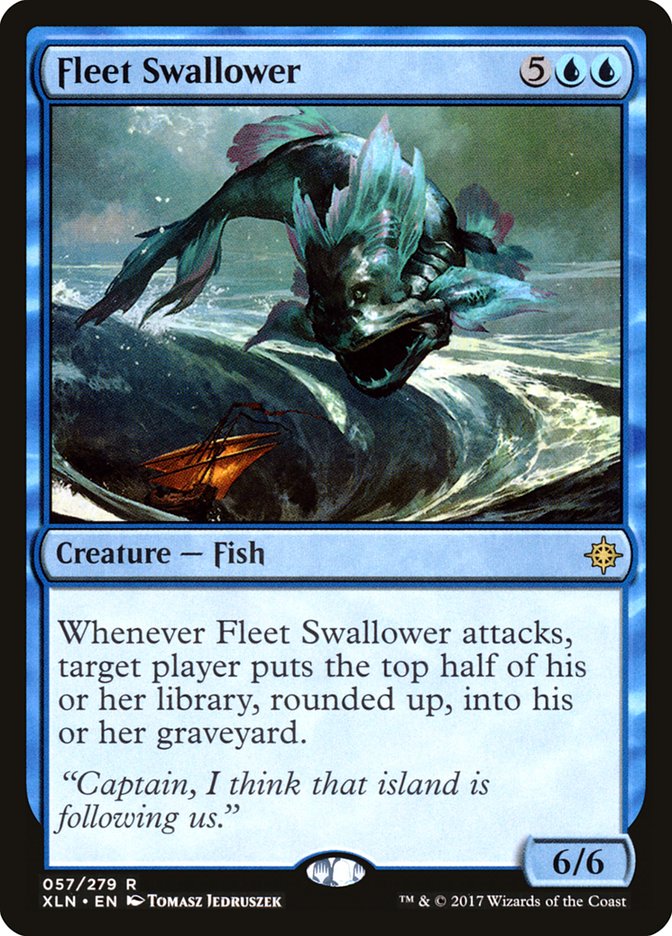
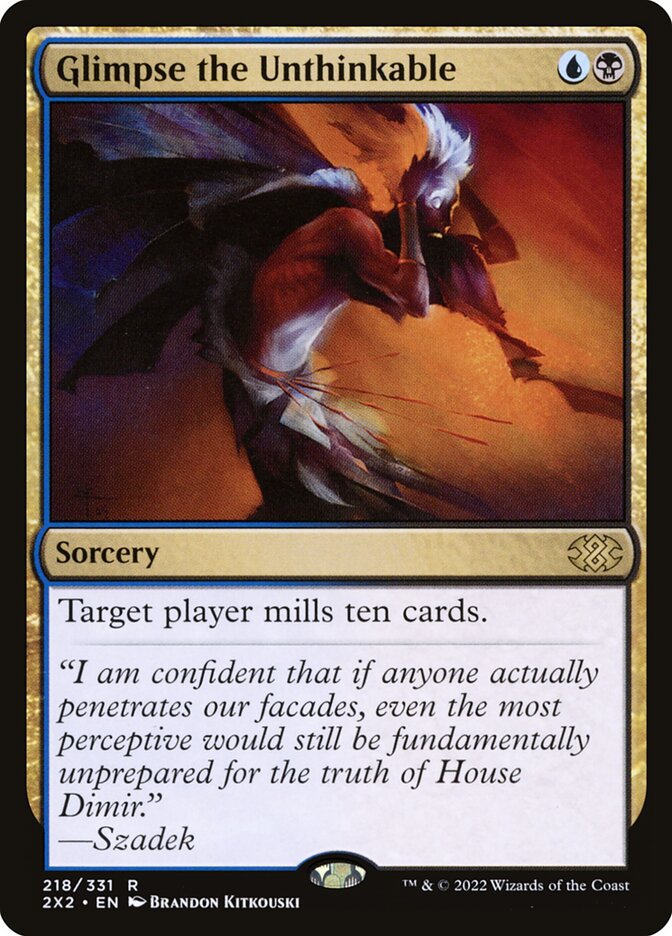
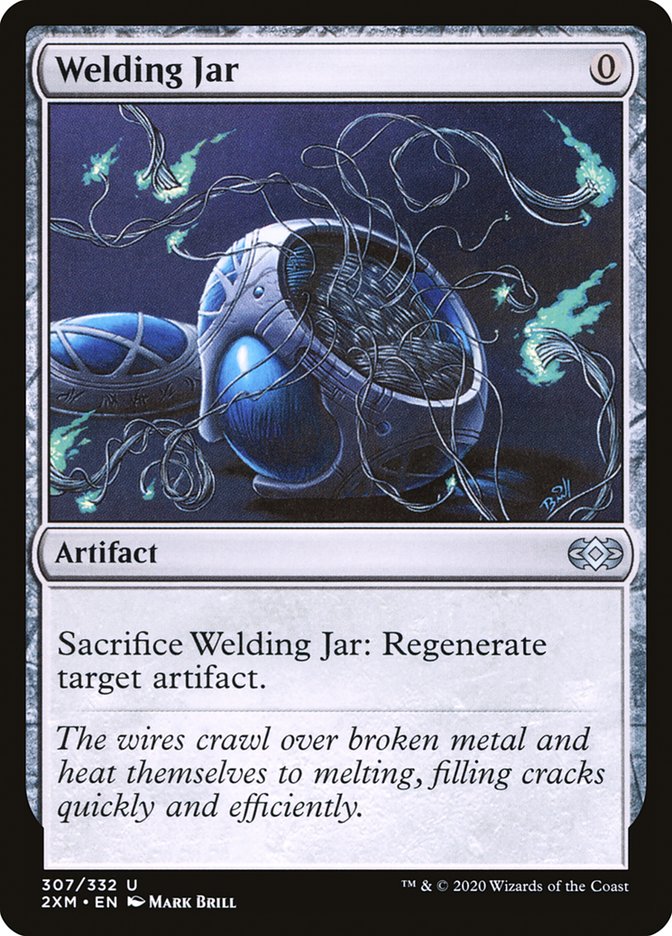
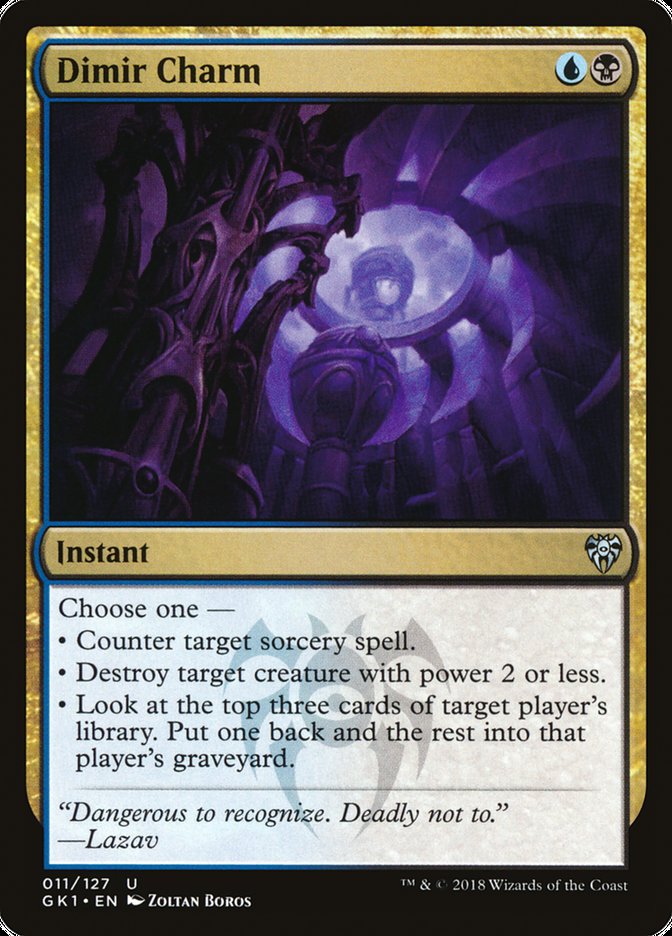
Iteration #3
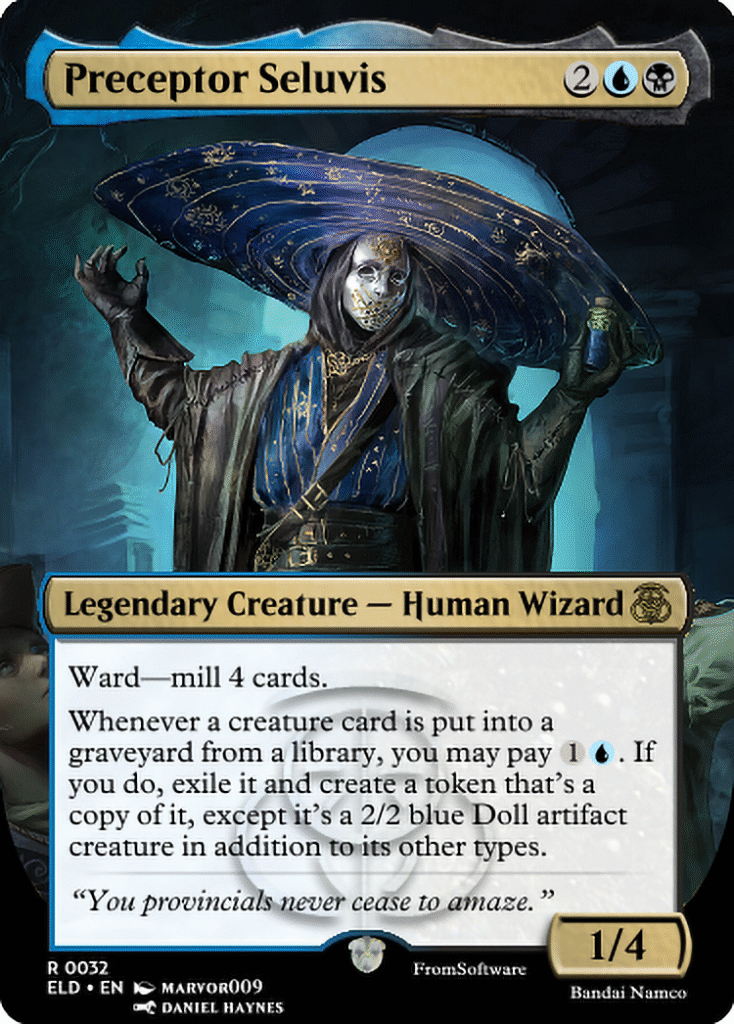
New changes I made:
- Cost – increased by 1 colourless mana.
- New art, woo!
Seluvis felt pretty great in the previous iteration, so I didn’t want to change him too drastically for this version. I could have changed both the cost of his ability AND his card cost, but I believe the major issue to be with his initial cost, putting more emphasis on his initial casting, then leaving the job of removing his powerful ongoing effect to the opponents. He should still feel like a ticking time bomb on the game table once down.
I learnt in his last iteration, however, that Seluvis’ biggest weakness tends to be card draw. I ended up settling on a creature-centric mill deck, with a strategy of mostly self-mill in order to mill my own handpicked set of powerful creatures (shown in the list above). This led to a much tougher time committing to card draw and staying on top of things. If Seluvis died, that would usually be a huge setback for his pacing but not game ending.
Overall, there isn’t too much to say with this version apart from the results from his testing. Hopefully, his pacing feels better and more balanced! Let’s see!
What I found out from playtests…
- The ability cost of (1)U was a big point of contention. My opponents tended to think it was too cheap of a cost for its strength. I was able to perform big mill effects, and sift through creatures to make potentially game-changing decisions decently often – especially if I had 4+ mana and got a good selection.
- However, it was difficult tell if the card earned it or had to work for it. In my opinion when playing him, I had to reserve a lot of mana, have him protected, have the mill cards in hand to trigger him, and choose the right player’s library to target, which felt like a pretty sizable commitment for its payoff.
- It is worth noting that this feedback seemed to be given when 1; Seluvis’ removed the opponent of their gameplan, 2; he managed to get lucky enough to summon a good creature early, or 3; I had enough mana when he triggered to sift through a LOT of cards and take them all at once.
- A suggestion to change the cost to UB, or (2)U instead was given by some testers, which is worth looking into.
Considerations for future changes
Overall, I’m very happy with how this card turned out. He feels fun to play, unique, allows plenty of skill expression, is tense to make decisions with, and has a euphoric payoff when hitting the right cards. I am done with Seluvis at this point, and will move onto other cards for the time being.
These are the last things I would change:
- Consider changing his ability cost to something harder to spam when hitting a huge instance of card mill.
- Look into if his Human Wizard creature types cause any problems across the board for balance.
- Reconsider his statline vs cost to test a more combat-driven version of him where he is designed to swing at the opponent instead.
Phew! That was a hefty deep dive. Thank you for reading all this way and please look forward to a peek into my future processes for some upcoming cards I have in the works! Ciao.

